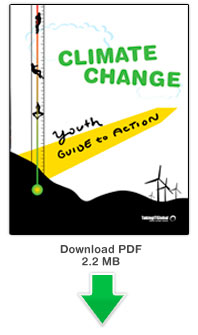 Download the Climate Change Guide to Action In English (PDF, 2.2 MB) |
Link source - Taking IT global
Climate change is any shift in weather patterns lasting at least 30 years. The term “climate” is often confused with weather, which is the short term measurement of atmospheric conditions such as temperature and precipitation patterns. Therefore, while a single hot year might not indicate climate change, a trend toward higher temperatures over many years would.
Most scientists agree, climate change is happening today in the form of manmade global warming. This warming largely began with the Industrial Revolution, which dramatically increased fossil fuel consumption and the release into the atmosphere of greenhouse gases (GHGs), most notably carbon dioxide (CO2). GHGs increase global temperatures by preventing heat from the sun from escaping into outer space. As GHGs accumulate in the atmosphere, so does this solar energy, resulting in steadily rising temperatures in recent decades.
Climate change also occurs naturally depending on many variables including the cyclical changes in the Earth’s position relative the sun and and volcanic activity levels. Historically, the Earth has passed through cool and warm stretches. Typically, colder glaciations last for roughly 100,000 years, while hotter interglacial periods, which is what we’re in today, last for closer to 10,000 years.
Present day warming has caused a broad range of negative consequences and is likely to create more unless stopped. The most direct effects of current climate change are on temperature and precipitation patterns. As of 2006, all eight of the hottest years ever recorded were from the last 10 years. As this warming continues, established weather systems will shift and become more extreme, resulting in both more droughts and floods. As sea surface temperature rises, weather-disturbing El Niño events will become more frequent and powerful. Meanwhile, larger, more severe hurricanes, which feed on the heat of ocean waters, will threaten coasts. This trend may already be visible: the last two decades have seen a sharp increase both in the frequency and power of hurricanes.
Shifts in temperature and precipitation will be a shock to fragile ecosystems which depend on specific climatic conditions. Many species will be unable to adapt as fast as their environment changes and face sharply reduced numbers or extinction.
Plants and animals aren’t the only ones feeling the pressure of changing ecosystems. Many regions will face severe water shortages in a warmer world, creating the potential for conflict. It is believed that the genocide in Sudan’s Darfur region is at least in part a response to water shortages resulting from global warming. In recognition of this growing danger, the 2007 Nobel Peace Prize was awarded to anti-warming crusaders including the United Nations’ Intergovernmental Panel on Climate Change (IPCC) and Al Gore.
An additional threat of climate change is rising sea levels. The main causes of this are the expansion of water as it warms and the flow of melt waters from once land trapped ice to oceans. Though it’s unclear exactly how much oceans will rise, the IPCC projects increases between 9 and 88cm in the 21st century. In this range, many coastal regions including cities would be threatened, and at a time when 70% of the world’s population lives on coastal plains.
Global warming is arguably the greatest danger facing humanity in the years ahead. In many ways, its effects are already being felt and it is too late to prevent warming entirely. However, the situation is not without hope. Though urgent action is needed, through the combined efforts of governments, businesses, scientists, and individuals, it is still possible to stop even greater tragedies and protect the health of our planet for future generations.